Angles in the same segment of a circle are equal
Categories: gcse geometry

Angles in the same segment of a circle are equal. In this article we will explain what this means, and prove that it is true.
Angles in the same segment
In this diagram, the chord RQ divides the circle into two segments (see parts of a circle). The larger segment (the major segment) is coloured magenta and the smaller one (the minor segment) is yellow.
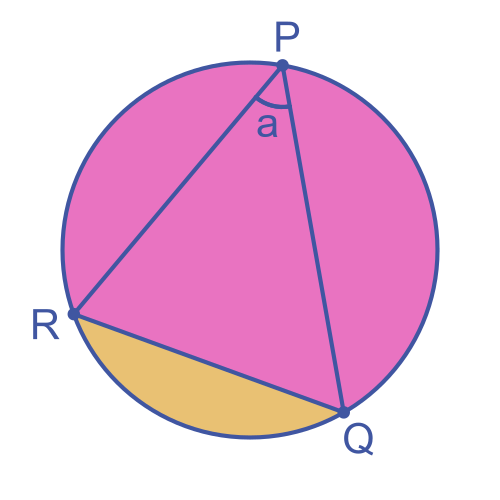
The angle a at point P is called the angle in a segment (in this case it is the angle in the major segment).
Here is point S, at a different position on the circle:
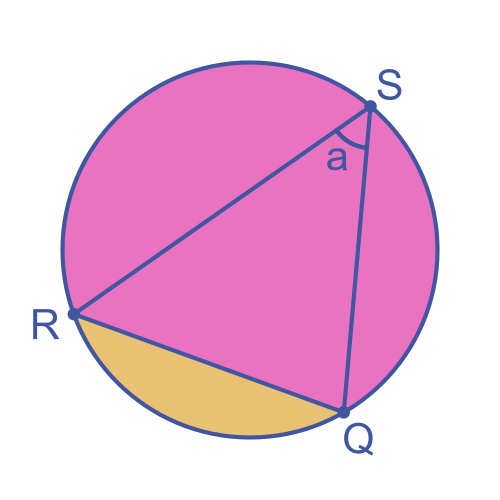
The chord RQ hasn't changed, and S is still in the major segment, so S is in the same segment as P. So by the angles in a segment theorem, the angle at S is equal to the angle at P, which is a.
Angles not in the same segment
Here is another case:
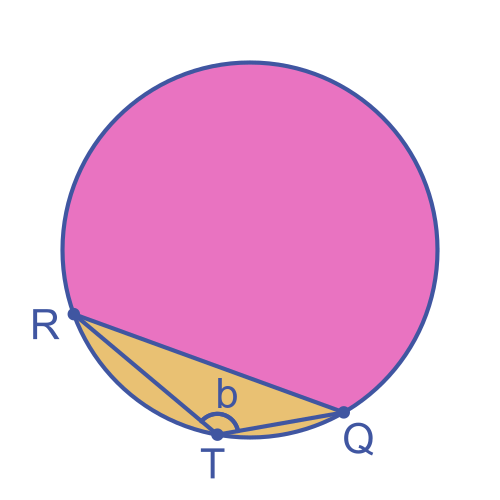
In this case, the chord RQ remains unchanged, but the point T is now in the minor segment (yellow) so it is not in the same segment as P. We will call this angle b, and it will not generally be equal to a.
In fact, angles a and b are opposite angles in a cyclic quadrilateral, so they add up to 180°.
Proof
The proof for this theorem is similar to the proof that the angle at the centre of a circle is twice the angle at the circumference.
We construct three triangles like this, where point O is the centre of the circle:
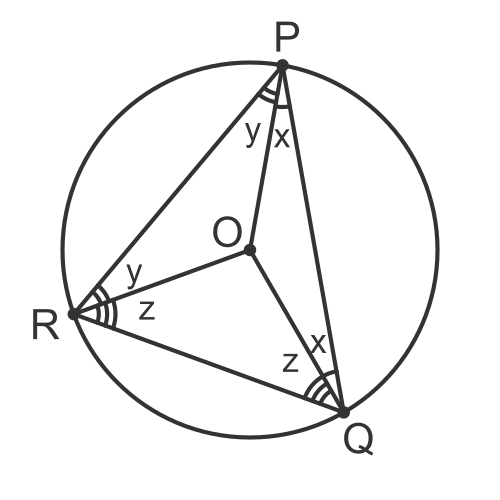
Notice that OP, OQ and OR are all radii of the circle. There is a circle theorem that tells us that 2 radii form an isosceles triangle. We know that the two angles at the base of an isosceles triangle are equal.
This means that:
- The two angles at the base of triangle PQO are equal, and we will call that angle x.
- The two angles at the base of triangle PRO are equal, and we will call that angle y.
- The two angles at the base of triangle QRO are equal, and we will call that angle z.
We can find the three angles of the triangle PQR, from the diagram:
- Angle P is x + y.
- Angle Q is x + z.
- Angle R is y + z.
Since we know that the three angles in a triangle add up to 180°, this gives us:

This can be rearranged as:

We know that the angle at P (angle a) is equal to x + y. So we can replace 2x + 2y with 2a in the earlier equation, to get:
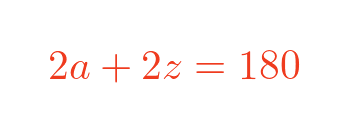
Which means:
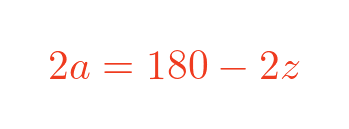
Dividing both sides by two gives:
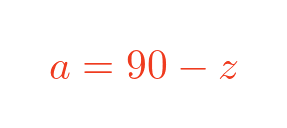
The angle z is determined by the triangle QRO. If we move the point P, it has no effect on points Q, R, or O. So moving point P does not change angle z.
Since angle a only depends on z it follows that moving point P will not change a, which proves the theorem.
See also
- Parts of a circle
- Perpendicular bisector of chord theorem
- Angle at the centre of a circle is twice the angle at the circumference
- Angle in a semicircle is 90°
- Opposite angles in a cyclic quadrilateral add up to 180°
- Tangent and radius of a circle meet at 90°
- Two tangents from a point have equal length
- Alternate segment theorem
- Two radii form an isosceles triangle

Join the GraphicMaths Newletter
Sign up using this form to receive an email when new content is added:
Popular tags
adder adjacency matrix alu and gate angle answers area argand diagram binary maths cartesian equation chain rule chord circle cofactor combinations complex modulus complex polygon complex power complex root cosh cosine cosine rule countable cpu cube decagon demorgans law derivative determinant diagonal directrix dodecagon eigenvalue eigenvector ellipse equilateral triangle euler eulers formula exercises exponent exponential exterior angle first principles flip-flop focus gabriels horn gradient graph hendecagon heptagon hexagon horizontal hyperbola hyperbolic function hyperbolic functions infinity integration by parts integration by substitution interior angle inverse hyperbolic function inverse matrix irrational irregular polygon isosceles trapezium isosceles triangle kite koch curve l system line integral locus maclaurin series major axis matrix matrix algebra mean minor axis n choose r nand gate newton raphson method nonagon nor gate normal normal distribution not gate octagon or gate parabola parallelogram parametric equation pentagon perimeter permutations polar coordinates polynomial power probability probability distribution product rule proof pythagoras proof quadrilateral questions radians radius rectangle regular polygon rhombus root sech segment set set-reset flip-flop sine sine rule sinh sloping lines solving equations solving triangles square square root standard curves standard deviation star polygon statistics straight line graphs surface of revolution symmetry tangent tanh transformation transformations trapezium triangle turtle graphics uncountable variance vertical volume volume of revolution xnor gate xor gate